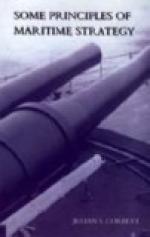All objects, whether ulterior or not, may be positive or negative.
A positive object is where we seek to assert or acquire something for ourselves.
A negative object is where we seek to deny the enemy something or prevent his gaining something.
Where the object is positive, Strategy is offensive.
Where the object is negative, Strategy is defensive.
This is the only certain test by which we can decide whether any particular operation is offensive or defensive.
Ulterior objects are not necessarily the same in their nature as the primary or secondary objects which lead up to them; e.g., ulterior objects may be offensive, while one or more of the primary objects may be defensive, and vice versa. For example, in the Russo-Japanese War the ulterior object of the war (to drive Russians from Manchuria) was offensive (positive). The ulterior object of the fleet (to cover the invasion) was defensive (negative). Its primary object to effect this was to attack and destroy the Russian naval force. This was offensive (positive).
Relation of Offensive to Defensive
The Offensive, being positive in its aim, is naturally the more effective form of war and, as a rule, should be adopted by the stronger Power. The Defensive, being negative in its aim, is the more lasting form of war, since it requires less force to keep what one has than to take what is another’s, and, as a rule, is adopted by the weaker Power. In most cases where the weaker side successfully assumes the offensive, it is due to his doing so before the enemy’s mobilization or concentration is complete, whereby the attacking force is able to deal in succession with locally inferior forces of the enemy.
The advantages of the Offensive are well known.
Its disadvantages are:—
That it grows weaker as it
advances, by prolonging its communications,
and that it tends to operations
on unfamiliar ground.
The advantages of the Defensive are chiefly:—
Proximity to the base of supply
and repair stations, familiar ground,
facility for arranging surprise
by counter attack, and power of
organising in advance.
The disadvantages of the Defensive are mainly moral. They become, however, real and practical when the enemy’s objective or line of operations cannot be ascertained, for then we have to spread or attenuate our force to cover all probable objectives, but this disadvantage can be neutralised when it is possible to secure an interior position.
Functions and Characteristics of the Defensive
True Defensive means waiting for a chance to strike.
To assume the defensive does not necessarily mean that we do not feel strong enough to attack. It may mean that we see our way by using the defensive to force certain movements on the enemy which will enable us to hit harder.




